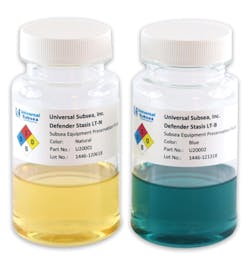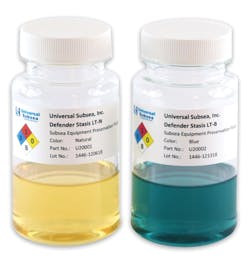USI unveils subsea equipment preservation fluid
Universal SubseaInc. (USI) has introduced Defender Stasis LT, a subsea equipment preservation fluid. It is a patented, lightweight, nontoxic, biodegradable preservation fluid that provides long-term protection for subsea equipment components and interface profiles. The company says the fluid is compatible with all commonly used metals and nonmetallic materials in oilfield service.
Sean Thomas, P.E, general manager, USI said: “… Defender Stasis LT is the first subsea wellhead preservation fluid that meets regulatory requirements for 24-hour per day use in offshore oil producing countries worldwide.”
According to USI, the requirement for the product was identified during development of its nonmetallic, low-pressure, subsea isolation cap product line. The company needed a lightweight preservation fluid for subsea wellheads and trees for long-term use, temporary abandonments and permanently abandoned wells. However, commercially available fluids exhibited major shortcomings, the company said, including high toxicity, potential for elastomer attack, improper specific gravity, elevated flammability or undesirable sheen-forming properties.
Defender Stasis LT has been designed to provide long-term protection for subsea equipment components and interface profiles. (Courtesy Universal Subsea Inc.)
“Subsea wellhead preservation fluids are discharged directly to the marine environment,” Thomas said. “We wanted a fluid that would be completely nontoxic to aquatic life while providing the lowest overall environmental impact. We recognized that the offshore market needed a better subsea wellhead preservation fluid, and we set out to develop a best-in-class product. Defender Stasis LT provides a long shelf life and service life but biodegrades rapidly if released to the environment.”
Also, corrosion of large equipment assemblies and running tools is another widespread problem in the offshore industry. Large equipment often retains residual water in the internal bores from pressure testing or condensed humidity, which can cause corrosion and reliability problems. The company said that the new fluid is ideal for subsea equipment preservation use to protect the internals of subsea trees, subsea manifolds, jumpers, flowlines and PLETs/PLEMs during shipping, storage or wet parking.
Thomas added: “…The naturally high polarity of this bio-based fluid provides superior wetting and water displacement properties. The base oils in the fluid will actively out-displace water, other aqueous fluids and most petroleum-based fluids, supplemented with special corrosion inhibitor additives to fully protect metallic components from corrosion. The fluid is more benign to nonmetallic materials than alternative fluids, which can attack nonmetallic seals and coatings in some instances.”
In addition, the fluid is rated as a fire-resistant hydraulic fluid because of very low volatility with a high flash point and high fire point. It has negligible toxicity in the event of personnel exposure and is rated as a negligible hazard or minimally toxic for all personnel ratings.
Plus, the fluid is recyclable and can be reprocessed to its original specifications. For shipping or storage applications where the preservation fluid is recovered after use, customers can choose to recycle the fluid rather than paying for disposal costs, the company said. This option not only avoids disposal costs but also provides cost savings for the recycled fluid compared to the cost of new preservation fluid. •

